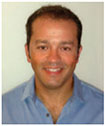Air pollution: new insight from direct measurements of ozone production
Piero Di CarloA Centre of Excellence for the Remote Sensing and Forecast of Severe Weather (CETEMPS), University of L’Aquila, I-67010 Coppito, L’Aquila, Italy. Email: piero.dicarlo@aquila.infn.it
B Department of Physical and Chemical Sciences, University of L’Aquila, I-67010 Coppito, L’Aquila, Italy.

Piero Di Carlo has been Assistant Professor with tenure at the University of L'Aquila (Italy) since April 2008. His main interest is the chemistry and physics of the atmosphere. He has designed state-of-the-art instruments and used them onboard a research aircraft to study environmental issues such as urban ozone pollution and forest emission of biogenic volatile organic compounds. In 2011, he was the Director of the International Summer School (4th EUFAR FP7 Training Course) ‘School on Aircraft Techniques for the Studies of Atmospheric Chemistry’. He is an Associate Editor of the Open-Access journal Atmospheric Measurements Techniques. |
Environmental Chemistry 12(6) 706-707 https://doi.org/10.1071/EN15026
Submitted: 3 February 2015 Accepted: 10 March 2015 Published: 8 July 2015
References
[1] A. J. Haagen-Smit, Chemistry and physiology of Los Angeles smog. Ind. Eng. Chem. 1952, 44, 1342.| Chemistry and physiology of Los Angeles smog.Crossref | GoogleScholarGoogle Scholar | 1:CAS:528:DyaG38Xlt1OksA%3D%3D&md5=add8bb14e6839dbaa3e18abb5b6c43b3CAS |
[2] D. D. Parrish, H. B. Singh, L. Molina, S. Madronich, Air quality progress in North American megacities: a review. Atmos. Environ. 2011, 45, 7015.
| Air quality progress in North American megacities: a review.Crossref | GoogleScholarGoogle Scholar | 1:CAS:528:DC%2BC3MXhtlyjur7N&md5=80d2955fa2f31ad85f5406495791c026CAS |
[3] M. Cazorla, W. H. Brune, Measurement of ozone production sensor. Atmos. Meas. Tech. 2010, 3, 545.
| Measurement of ozone production sensor.Crossref | GoogleScholarGoogle Scholar | 1:CAS:528:DC%2BC3cXhtFSnur3P&md5=e5efde4b78ced895c6cf70c118fc976bCAS |
[4] Ground-Level Ozone in the 21st Century: Future Trends, Impacts and Policy Implications. Royal Society Policy Document 15/08 2008. (The Royal Society: London).
[5] C. N. Hewitt, A. R. MacKenzie, P. Di Carlo, C. F. Di Marco, J. R. Dorsey, M. Evans, D. Fowler, M. W. Gallagher, J. R. Hopkins, C. E. Jones, B. Langford, J. D. Lee, A. C. Lewis, S. F. Limg, J. McQuaid, P. Misztal, S. J. Moller, P. S. Monks, E. Nemitz, D. E. Oram, S. M. Owen, G. J. Phillips, T. A. M. Pugh, J. A. Pyle, C. E. Reeves, J. Ryder, J. Siong, U. Skiba, D. J. Stewart, Nitrogen management is essential to prevent tropical oil palm plantations from causing ground-level ozone pollution. Proc. Natl. Acad. Sci. USA 2009, 106, 18 447.
| Nitrogen management is essential to prevent tropical oil palm plantations from causing ground-level ozone pollution.Crossref | GoogleScholarGoogle Scholar | 1:CAS:528:DC%2BD1MXhsVGqtLvP&md5=d41c51ac6308e25813dee8f192c02999CAS |
[6] Air Trends 2011 (US Environmental Protection Agency). Available at http://www.epa.gov/air/airtrends/ [Verified 7 May 2015].
[7] Ground-level Ozone 2011 (US Environmental Protection Agency). Available at http://www.epa.gov/glo/actions.html [Verified 7 May 2015].
[8] Q. Zhang, D. G. Streets, G. R. Carmichael, K. B. He, H. Huo, A. Kannari, Z. Klimont, I. S. Park, S. Reddy, J. S. Fu, D. Chen, L. Duan, Y. Lei, L. T. Wang, Z. L. Yao, Asian emissions in 2006 for the NASA INTEX-B mission. Atmos. Chem. Phys. 2009, 9, 5131.
| Asian emissions in 2006 for the NASA INTEX-B mission.Crossref | GoogleScholarGoogle Scholar | 1:CAS:528:DC%2BD1MXhsFGhsrnE&md5=edce6238852cb9822fa8fa776b3036bdCAS |
[9] G. Tang, X. Li, Y. Wang, J. Xin, X. Ren, Surface ozone trend details and interpretations in Beijing, 2001–2006. Atmos. Chem. Phys. 2009, 9, 8813.
| Surface ozone trend details and interpretations in Beijing, 2001–2006.Crossref | GoogleScholarGoogle Scholar | 1:CAS:528:DC%2BC3cXhs1GjtLw%3D&md5=b72e6ce4406afdecef164efbad38ae66CAS |
[10] M. Cazorla, W. H. Brune, B. Lefer, Direct measurement of ozone production rates in Houston in 2009 and comparison with two estimation methods. Atmos. Chem. Phys. 2012, 12, 1203.
| Direct measurement of ozone production rates in Houston in 2009 and comparison with two estimation methods.Crossref | GoogleScholarGoogle Scholar | 1:CAS:528:DC%2BC38XltFSgsr0%3D&md5=2c95303fef8bc3b89b7a119adf8c64d9CAS |
[11] W. Wu, L. J. Mickley, D. J. Jacob, J. A. Logan, R. M. Yantosca, D. Rind, Why are there large differences between models in global budgets of tropospheric ozone? J. Geophys. Res. 2007, 112, D05302.
| Why are there large differences between models in global budgets of tropospheric ozone?Crossref | GoogleScholarGoogle Scholar |
[12] A. B. Gilliland, C. Hogrefe, R. W. Pinder, J. L. Godowitch, S. T. Rao, Dynamic evaluation of regional air quality models: assessing changes in O3 stemming from emissions and meteorology. Atmos. Environ. 2008, 42, 5110.
| Dynamic evaluation of regional air quality models: assessing changes in O3 stemming from emissions and meteorology.Crossref | GoogleScholarGoogle Scholar | 1:CAS:528:DC%2BD1cXntFGlu74%3D&md5=96a82327acf0201caf1d6b56c5f4961bCAS |


